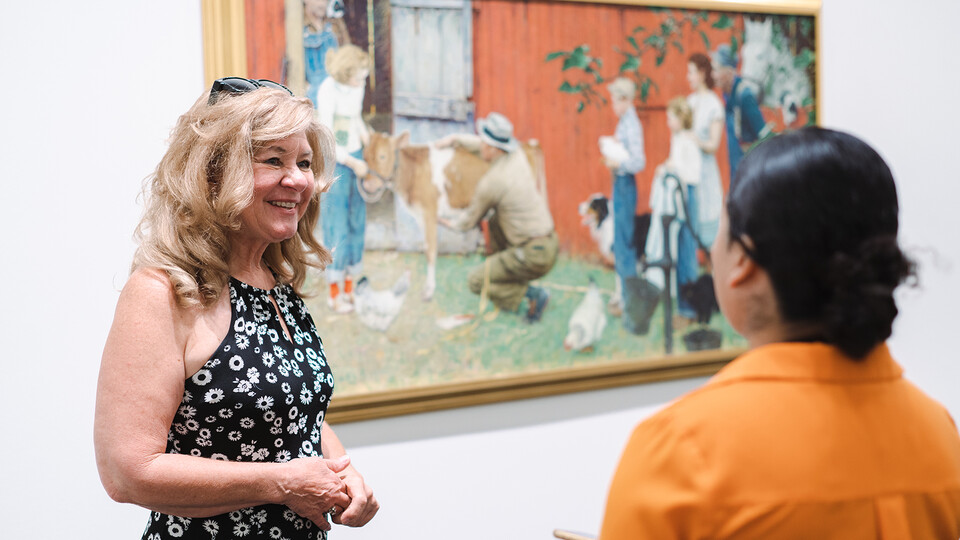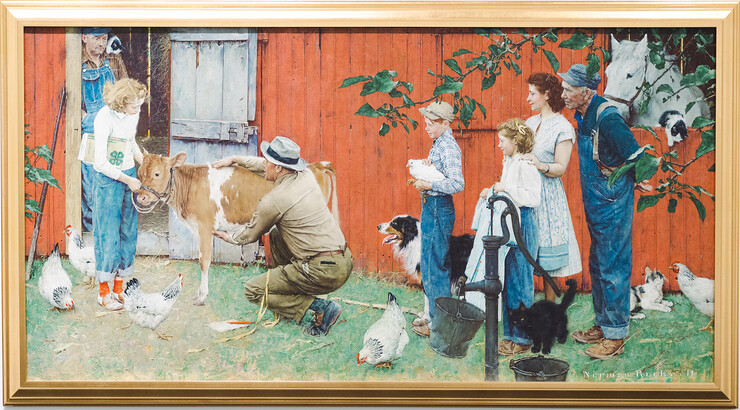· 5 min read
Farmers’ granddaughter views Norman Rockwell painting

Though it's closed while new exhibitions are under preparation, Sheldon Museum of Art gave Indiana-native Peggy Steed Montarsi the chance to view Norman Rockwell's "The County Agricultural Agent" during a stop in Lincoln.
Montarsi's grandparents and their children served as Rockwell's models for the oil painting, used to illustrate a July 24, 1948, article about county extension. Montarsi offered tidbits of family lore about the painting to reporters from the Lincoln Journal Star, KOLN/KGIN TV and KLKN TV.
A special visit was arranged for an Indiana woman at the Sheldon Art Museum. Her family served as models for a Norman Rockwell painting decades ago. https://t.co/EvqMNEuiMQ
— 1011 NOW (@1011_News) July 28, 2022
Montarsi, a crop insurance claims adjuster from Wind Lake, Wisconsin, spent much of July in Nebraska reviewing claims from hail storms in the Kearney area. She wanted to see the Rockwell painting before embarking on the 10-hour drive to return home. After she phoned the university to learn where she could view the painting, Sheldon officials agreed to open the gallery for her.
The painting is special to her family, she said, because her late grandparents, Don and Martha Steed of Jay County, Indiana, were the dairy farming couple depicted in the painting.
The painting shows her late father, Larry Steed, then 13, holding a chicken. Also pictured are her aunts, Sharon Steed Smith and Jama Steed Fuller. All are watching Harold Rippey, a county agent, measure a Guernsey calf in front of a red barn.
Many of her family members have small prints of the artwork, she said, but few have seen it in person. Montarsi has seen it once before, during an exhibition in 1997-98 in Fort Wayne, Indiana.
“It’s worth seeing in person,” Montarsi said, pointing out the painting’s intricacy. Details like the markings on the tape measure the agent uses to measure the calf to the shadows of hay visible in the barn doorway behind her father aren’t visible in the smaller prints owned by family members. “I could spend hours looking at it.”
The painting has been a part of Sheldon Museum of Art’s collection since 1969, donated by Lincoln philanthropist and former department store magnate Nathan Gold, who purchased it in 1951. “The County Agricultural Agent” was displayed in the Gold’s Department Store lunch room for many years before it was donated to Sheldon. Erin Hanas, Sheldon’s curator of academic engagement, described the Rockwell work as of the most popular works in the collection.
The Rockwell painting is among those the museum selected for a “Clocking In: Visions of Labor,” a new exhibition on labor-related themes that will open Aug. 16.
“The County Agricultural Agent” is a favorite of Chancellor Ronnie Green, whose academic background is in beef research. The painting highlights the importance of university extension to agriculture.
“The painting is very meaningful to me,” Green said. “I feel a huge history with it.”
Although Rippey worked for extension out of Purdue University in Indiana, he has many counterparts and successors in Nebraska who work closely with farmers and livestock producers to make sure they have the latest information and technology to run a successful agricultural business.
In addition to exhibitions at Sheldon and across the country, the painting was on view for long intervals at the Nebraska Center for Continuing Education (now known as Hardin Hall), between June 1969 and March 1995.
Montarsi offered tidbits of family lore to reporters from the Lincoln Journal Star, KOLN/KGIN TV and KLKN TV who came to interview her. Those tidbits included:
• The red barn in the background actually belonged to the neighbors, she said. Rockwell preferred that color over the Steeds’ white dairy barn;
• The two daughters ordinarily wore dresses around the farm, but donned blue jeans at Rockwell’s request;
• There are 13 animals in the painting, including chickens, a border collie and four cats; and
• The Guernsey calf was not show-worthy and the Steeds planned to get rid of it.
An Indiana woman in Nebraska on farm business took a quick detour to see a pretty special Norman Rockwell painting at the Sheldon.
Nice story from @evelynmejiaaa: https://t.co/wQCcaPciUE— Zach Hammack (@HammackLJS) July 28, 2022
The painting shows a cat perched on her grandfather’s shoulder — which she said seemed out of character for him. And the chicken in her father’s arms?
“My dad didn’t like chickens,” she said, with a laugh. “Holding a chicken is not a thing he would have done, ordinarily.”
Once one of America’s leading publications, with a peak circulation of about 6 million, the Saturday Evening Post frequently featured covers painted by Rockwell. The Steed family proabably was chosen to model because they were active in 4-H and other County Extension activities and knew Harold Rippey, whom the Post identified as “the typical county agent.” Montarsi said Rockwell took photos of the family for reference as he painted and he accepted their invitation for a fried chicken dinner. She doubted the Steeds realized how famous Rockwell would become or that the painting would gain national recognition.
Tears welled in Montarsi’s eyes as she talked about the 36-by-70-inch artwork. The farm, purchased by her great-great grandfather John Steed in 1824, was sold several years ago. Her Aunt Jama, now in her 90s, is the only member of the family still alive.
“It’s the people,” she said. “It’s the culture. It’s all disappearing. One hundred years of that is gone. My grandfather said he didn’t need to leave Jefferson Township (where the farm was located). He was satisfied living there, farming and making food. It meant so much to him.”








